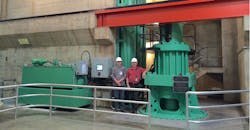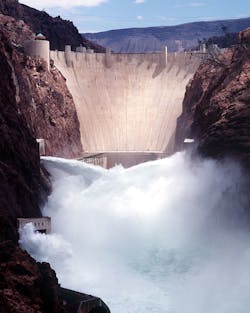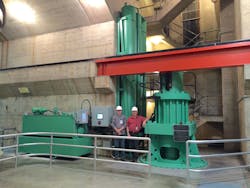Accumulators Help Upgrade Hoover Dam
The main challenge for modernizing and improving operation of Hoover Dam was to overhaul and upgrade a series of 50-ft-tall pressure-relief valves (PRVs) on turbines in the dam’s powerhouse and to convert them to a hydraulic control system. The project was awarded to Precision Machine & Supply Inc., (a division of Andritz Hydro), which had conducted work on the Hoover Dam since the 1990s.
“Because of the sheer complexity and logistics involved, this has been the most challenging thing I've ever done,” offers Dan Wenstrom, president of Precision Machine & Supply. “It was complicated to get the old equipment out and put the new equipment in, especially with all the restrictions operating in a concrete structure at the bottom of Hoover Dam.”
Hoover Dam is often called one of the modern wonders of the world. Standing more than 700 ft tall and containing more than 3.25-million cubic yards of concrete, the magnificent structure spans the Colorado River between Nevada and Arizona, forming the 247-square-mile Lake Mead reservoir behind it.
Hoover Dam generates more than 4 billion kW-hr of electricity every year by routing water from Lake Mead through a series of hydroelectric turbines. When a load rejection occurs, hydropneumatic accumulators help open relief valves to prevent damage to a turbine.
Generating Power from Water
The dam generates more than 4 billion kW-hr of electricity each year by taking diverted river water from the lake, under extremely high pressure, and channeling it into giant turbines at its base. The water to drive the turbines is fed by gravity through a series of large pipes called penstocks, which narrow from 30 ft to 13 ft as they descend, thus increasing pressure of the water. When the incoming water reaches this point, its pressure is 250 psi.
At the bottom of each penstock, the water then enters a turbine through a large steel wicket gate—each more than six-ft tall and weighing 1,500 lb. Each gate works like Venetian blind, opening and closing to control the volume of water flowing into the turbine. As water rushes through the wicket gate, it flows past blades that spin the turbine and drive a rotor inside a generator, which then creates a spinning magnetic field to produce electricity.
Hoover Dam has 17 turbines, each weighing about 700 tons, with generator shafts rotating at 180 rpm. While a turbine is spinning, energy is constantly being created and fed through power lines. However, if a sudden break or fault in the line occurs—called a load rejection—the turbine needs to stop as quickly as possible.
When a load rejection takes down a primary line—which can be caused by a lightning strike or actual physical damage to a transmission wire—there’s no place for that newly generated electricity to go. If that happens, the spinning turbine tends to overspeed, which can cause serious damage to the mechanism. Therefore, the water driving it has to be immediately shut off at the gates and simultaneously diverted around the turbine. However, that necessity comes with problems of its own.
Diverting Flow and Relieving Pressure
If the high-pressure water flow is stopped too abruptly, it results in a powerful water hammer effect when the backed-up pressure suddenly and violently slams into an obstruction. Kinetic energy of the water delivery system at Hoover Dam reduces the life of the penstocks.
To avert the effects of sudden load rejections, the original designers of Hoover Dam installed large pressure relief valves (PRVs) to quickly divert incoming water to past the turbines, thereby taking the generators offline. The first PRVs utilized water head pressure to drive large pistons to close tulip valves. Tulip valves are trumpet shaped, similar to those used in conventional automobile engines.
In recent years, though, questions arose about the original PRVs’ functional reliability to protect the aging water lines. The turbines at the dam were installed beginning in 1936. Naturally, then, the condition of the equipment and infrastructure inside the power plant were degraded by decades of use.
The turbines and all their plumbing are vintage—80 years old, in some cases—with a lot of wear and tear on them. Therefore, personnel at Hoover Dam were concerned about pressure spikes and the resulting negative impact they could have on the equipment. Precision Machine’s Wenstrom agrees. “Over the years, those pressure-relief valves became corroded. Also, the original valves were mechanically actuated and water-operated, because that’s all the technology they had in the 1930s.”
Developing the Solution
Aware of the critical need to optimize the reliable performance of the older pressure-relief valves, the operations team at Hoover Dam launched a long-term project to upgrade them. The main objective was to make the PRVs more responsive and functionally efficient when a power line break necessitated a generator shutdown.
The initial plan called for overhauling the existing valves by taking them apart and restoring worn components to like-new condition. The scope of the challenge—plus the restriction of not being able to shut down multiple turbines at the same time—meant the work would require many years to complete. Hoover’s plant personnel and Precision Machine began the first remedial work on the valves in 1998.
While that work was underway, Wenstrom came up with a unique design concept to standardize operation of the PRVs and make them digitally controlled. The dam’s original generating equipment was built by various manufacturers and installed over a span of years, so it was far from consistent. There are five separate turbine designs in operation at Hoover Dam. Even units built by the same manufacturer several years apart had differences.
“We showed Hoover personnel a design that would make the units fully compatible with their existing electronic control system that operated and controlled the generators,” Wenstrom adds. “We proposed converting all PRVs to be operated the same way and all controlled by hydraulic cylinders.”
The decision was made to go with hydraulic-driven pressure-relief valves which could provide very precise control and extremely fast response. The system would also reduce the number of false pressure relief valve operations that often occurred with the old mechanically operated PRVs. Wenstrom brought in Parker distributor Controlled Motion Solutions Inc. (Comoso) to engineer and supply the hydraulic power unit and manifold mounted to the hydraulic cylinder.
A bank of three accumulators—each more than 16-ft long and with a dry weight of more than eight tons—is shown being lowered to an area where it will provide hydraulic power to a cylinder will rapidly open a relief valve on command. Inset photo shows accumulator assembly arriving at area for transfer to work site.
Auxiliary Power Needed
The hydraulic controls required accumulators for energy backup. Accumulators enable a hydraulic system to respond quickly to a temporary demand and allow using a less-powerful pump. Each accumulator acts as a large, high-energy battery to supplement pump flow in operating a PRV. The accumulator stores hydraulic energy until it’s needed for immediate use. Supplemental power from the accumulators is necessary because of how Hoover Dam’s hydroelectric equipment is configured.
Parker's Accumulator and Cooler Division was given the assignment to design the best units for Hoover Dam’s requirements. Working closely with Comoso and Precision, Parker came up with a practical, cost-effective solution. The accumulators instantly release 750 to 900 hp, providing the energy needed to immediately open the valves on demand.
Ironically, access to electricity is very limited where the PRVs are located in the dam. The dam puts out 185,000 hp per turbine, but the equivalent of only 10 hp was accessible in the work area. The power that is available inside the dam itself comes from two smaller separate generators in the powerhouse. These units simply wouldn't be able to transmit enough energy to operate high-horsepower hydraulic pumps to drive the cylinder when a PRV trips.
Each pressure-relief valve at Hoover Dam now uses one hydropneumatic piston accumulator with pressurized oil (180 gal under 2,750 psi) and two large nitrogen-gas bottles. The accumulators have a 20-in. bore and an outside diameter of 23 5/8 in. Each accumulator is more than 16-ft long and a dry weight of 8,653 lb. A total of 17 accumulators and 34 nitrogen gas bottles have been installed.
Outstanding Results
As the upgraded PRVs are designed, we now get shaft movement typically within less than a tenth of a second after the signal is received that the generator is going into emergency shutdown. As quickly as the (water intake) gates close, the PRV has to open to bypass the same amount of water that was otherwise going through the turbine. This all must happen within 10 sec. Most critical is that once the PRV is fully open, it has to close gradually to prevent creating a water hammer.
With the installation of each new pressure-release valve, a commissioning team—with representatives from Hoover Dam, Precision Machine, Comoso, and Parker Hannifin—conducts a detailed testing process.
“To do the commissioning, we bring the generator up to speed and then trip it to simulate an emergency shutdown,” Wenstrom explains. “Recording devices with transducers on the turbine side and PRV side precisely measure the hydraulic pressures, strokes, and the time it takes each cylinder to respond to the emergency closure signal. Then we measure the amount of time it takes the pressure-relief valve to open and to reclose. The whole intent is that these PRVs have to open very quickly—as soon as the wicket-gate starts to close—to prevent a water hammer.”
Shown here is the work site after project completion. At left is the hydraulic power unit; in center, behind men, is a bank of accumulators; at right is the top of the top of a pressure relief valve assembly.
Bonus Benefits
In addition to dramatically improving the functionality and reliability of the PRVs, the hydraulically driven system provides a solution to a new problem at Hoover Dam: Quagga mussels.
An invasive species of Quagga mussels had made its way into the Colorado River and Lake Mead, and by 2009 the mussels actually started plugging up water passageways in the dam’s control valve system. They clog PRVs by clinging to the rods that open and close the valves, and in some cases even prevented them from opening.
Wenstrom’s design to modernize the PRVs ensured they would operate regardless of any fouling factors such as the Quagga mussels. The hydraulic-driven PRV has the brute force to plow through any obstruction in its path. The impetus of the conversion to the hydraulic design wasn’t the mussels, but it turned out to be a great secondary benefit.
The entire process of upgrading the pressure-relief valves and associated equipment has been an extraordinary team effort representing a lot of combined brainpower. Ultimately taking 20 years from start to finish, the scope and uniqueness of the project seem appropriate for such a magnificent historic facility.
Greg Paddock is hydraulic territory manager, Steve Camp is regional manager, and Jeff Sage is product manager at Parker Hannifin’s Accumulator and Cooler Division. This information is excerpted from Parker Hannifin’s Motion & Control Technology Blogs.
About the Author

Leaders relevant to this article:





